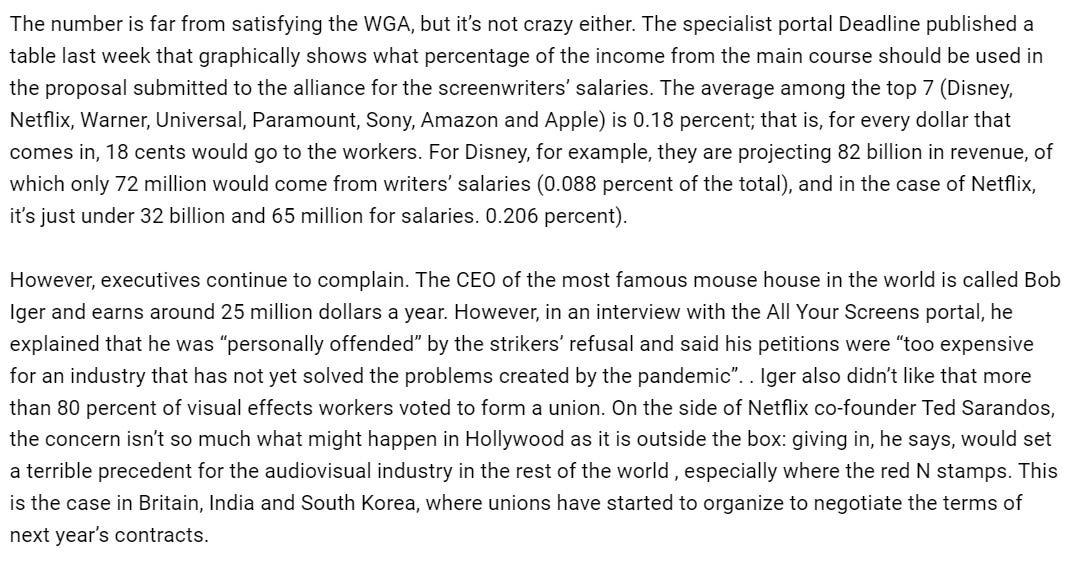Too Much TV: Your TV Talking Points For Friday, September 15th, 2023
You can't understand streaming TV without understanding "customer lifetime value"
Here's everything you need to know about the world of television for Friday, September 15th, 2023.
I CAN ONLY HOPE NO HUMAN WROTE THIS STORY
Like any journalist with a healthy ego, I have a couple of Google News alerts set up to let me know when someone mentions this newsletter or my web site. A story recently popped up from a publication called NationWorldNews.com and all I can hope is that it is AI-generated. Because if a human writer is responsible for "Hollywood Was Still Paralyzed After The Strike," the state of journalism is in more trouble than I thought:
On the upside...hey, I own a "portal."
THE DANGERS OF 'CUSTOMER LIFETIME VALUE' WHEN APPLIED IN THE STREAMING VIDEO WORLD
I've spent most of today having discussions about the differences between the old broadcast TV business model and the economics of streaming videos, especially SVODs. I hear a lot of "tech bro" complaints or how tech industry executives don't "understand" how Hollywood works. And while that might be true, it's just as certain that most Hollywood industry types don't much understand the vast differences between how the TV business determined value in the linear world vs. how it's figured in the digital world.
I apologize in advance to some of you, because this is an extremely abbreviated explanation and I know I am glossing over many important things. But this is a newsletter, not a novella.
In the old broadcast and cable world, making money and determining value was complicated, but the general outlines are easy enough to be understood by most civilians. You produce some programming, and hopefully it draw enough viewers to allow the network to sell enough ads at a price where there's a profit. And yes, there was network branding that played into that as well as things such as carriage subscription fees once cable television rolled out. But because viewers could turn the channel whenever they wanted, the primary driver for any network was to get as many eyeballs at any one particular time as possible. That is how you made money.
SVODs have a business model that couldn't be more different. Because your viewers have to make the conscious decision to subscribe (and to keep subscribing), the economic factors that matter the most are the ones that revolve around the cost of finding the subscribers and keeping them happy enough to pay up every month. Simple viewing numbers don't provide much clarity on those two important metrics. So the focus is on something called "customer lifetime value."
You figure out your customer acquisition cost (CAC) - or what you have to spend for each person who subscribes - and measure that against the customer lifetime value and you have a pretty good metric to use to help determine how much you should be spending on everything from salaries and marketing to content production and overhead.
Simply put, the customer lifetime value is the total worth of each customer throughout the life of your relationship with them. That includes all sorts of data points, ranging from how long each subscriber is likely to stay before churning off, the price they're paying each month, etc. If you can accurately figure that out, you can compare the customer acquisition costs to the customer lifetime value and use that to help you predict a wide variety of future business decisions.
It's not just whether or not you'll be profitable, but it helps you to make all sorts of related strategic decisions. If accurate, it gives you a bird’s-eye view of your marketing expenses, efforts, campaigns, and strategies. You can use it to balance short and long-term financial goals. You can figure out which spending is bringing the best return and where to focus future efforts.
It can also help you identify high-value customers. In the case of SVODs, that means customers who are likely to stay subscribed for a long period of time.
The related side of this is that you can also determine which decisions might help that overall customer lifetime value. Increasing that CLV at a rate lower than you are increasing spending is basically increasing your revenue stream and your profits.
When applied correctly, that CLV number can be used to help determine what content is most valuable to the bottom line. For instance, a show that draws in an above-average number of new subscribers (which lowers customer acquisition costs) would have more value to a streamer than another series that generates five times the views, but many fewer new subscribers. And as you can imagine, there are all sorts of variations of this equation.
The problem at a lot of companies (Warner Bros. Discovery, I'm looking at you), is that it can tempting to tweak the equations in order to justify business decisions you've already decided to make.
In the abstract, CLV is determined by this equation:
Customer Lifetime Value (CLV) = (ARPA × Gross Margin)÷ Churn Rate
In other words, you estimate the average revenue per account by the gross margin and divide by the estimated subscriber churn percentage each month.
But while that formula sounds straight-forward enough, if you are wrong in any assumption, your bottom line can quickly go sideways.
Let's say that hypothetically you're a media company that has two subscription streaming services that are both somewhat complimentary but still competing with each other for subscribers. Company executives could decide to combine the two services and assign a series of values to the move that would end up lowering the customer acquisition costs while also lowering the churn rate. That would create a larger potential revenue stream and that company could spend extra money on content and marketing based on that estimated increase in revenue.
The problem is that if you spend the money before you learn whether or not your decision to combine the services resulted in the increases you anticipated, you are somewhat screwed if it turns out your strategy was wildly optimistic. You've now spent money on programming your business model can't support right now. And now you have to figure out how to "right-size" your bottom line.
This is just one very simplified example. But it also helps explain some of the business decisions you are seeing now in the streaming video business. Yes, the streaming business will never deliver the gross margins of the traditional linear TV business at its peak. But the economic problems are not the result of smaller gross margins. Instead, they are mostly caused by executives making strategic decisions that turned out to be not the wisest moves they could have made.
This is also why I try and counsel writers, actors, directors and other creatives to not become laser-focused on raw viewing numbers. Yes, there an indicator of possible success. But the bottom line in streaming is much more complicated than measuring eyeballs.
ODDS AND SODS
* Kate Lindsay describes her Embedded newsletter as "an essential guide to what's good on the internet," and basically what that means is that she does a great job of highlighting people and trends you should know. I was fascinated by her piece on 23-year-old Kelsey Russell, who has built a following reading and discussing stories she finds in that day's New York Times.
* Former TBS and TNT GM Brett Weitz has been hired to be head of content, talent, and brand sales at X. Carrie Stimmel, who had previously been chief growth officer for NBCU’s Olympics ad business, is also joining X as its its global agency leader.
* The 4-H has teamed up with Netflix's Spy Kids: Armageddon to launch new learning platform Clover.
WHAT'S NEW TODAY AND THIS WEEKEND:
FRIDAY, SEPTEMBER 15TH:
* A Million Miles Away (Prime Video)
* Come Fly With Me (Hallmark Movies And Mysteries)
* El Conde (Netflix)
* Elevator Game (Shudder)
* Heels Season Two Finale (Starz)
* Inside The World's Toughest Prisons Season Seven Premiere (Netflix)
* Lang Lang Plays Disney (Disney+)
* Love At First Sight (Netflix)
* Love After Lockup Season Premiere (Netflix)
* Master & Apprentice: A Special Look At Ahsoka (Disney+)
* Miseducation Series Premiere (Netflix)
* Rotting In The Sun (Mubi)
* Surviving Summer (Netflix)
* The Club (Netflix)
* The Last Drive-In With Joe Bob Briggs: The Walking Dead: Daryl Dixon (AMC/Shudder)
* The Latin Music Revolution: A Soul Of A Nation Presentation (ABC)
* Wilderness (Prime Video)
* Written In The Stars Series Premiere (Prime Video)
SATURDAY, SEPTEMBER 16TH, 2023:
* All Rise Mid-Season Premiere (OWN)
* Craft Me A Romance (Great American Family)
* 48 Hours Season Thirty Six Season Premiere (CBS)
* How She Caught A Killer (Lifetime)
* Love & Marriage: Huntsville Season Premiere (OWN)
* Notes Of Autumn (Hallmark)
SUNDAY, SEPTEMBER 17TH, 2023:
* Building Roots (HGTV)
* Gold Series Premiere (Paramount+)
* Halloween Wars Season Premiere (HGTV)
* One Night Stand Murder (Lifetime)
* Psycho: The Lost Tapes Of Ed Gein (MGM+)
* Relative Race Season Twelve Premiere (BYUtv)
* 60 Minutes Season Fifty-Six Season Premiere (CBS)
* The Gold (Paramount+)
* Yellowstone Broadcast Series Premiere (CBS)
MONDAY, SEPTEMBER 18TH, 2023:
* Mrs. Sidhu Investigates Series Premiere (Acorn TV)
* My Little Pony: Make Your Mark (Netflix)
* Neighbours Season Premiere (Freevee)
* Superpower (Paramount+)
* The Chelsea Detective Season Two Finale (Acorn TV)
* The Academy Of Country Music Honors (Fox)
* The Big Bake Season Premiere (Food)
Click Here to see the list of all of the upcoming premiere dates for the next few months.
SEE YOU MONDAY!
If you have any feedback, send it along to Rick@AllYourScreens.com and follow me on Twitter @aysrick.




